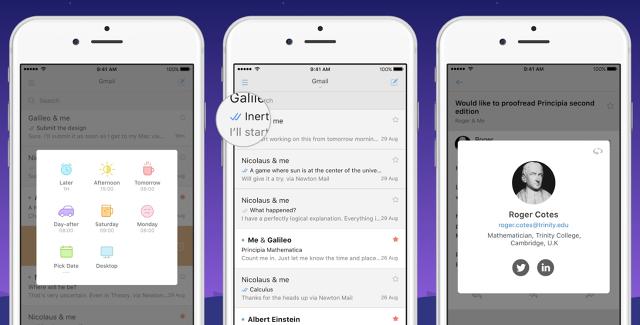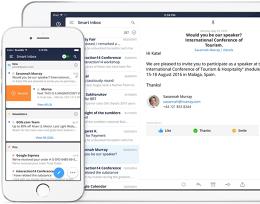There’s Still Hope For Email—But You’ll Have To Pay For It
It’s hard to believe that people once lined up to try a new email app, but a few years ago, mobile email was so inefficient that more than 1 million people joined a waitlist for an alternative called Mailbox. With features like swipe-to-delete and “snooze” for responses, Mailbox proved that email could be better, and it inspired a wave of similar apps.
The boom didn’t last: Mass-market email apps proved unsustainable on their own, while big tech firms like Google and Microsoft snatched up some of the more innovative startups, only to rebrand them or roll them into existing products. Mailbox itself got acquired by Dropbox, which decided to shut down the app last year due to a lack of consumer interest. You don’t hear much about innovative new email apps for consumers anymore, because there’s no money in it.
That doesn’t mean email innovation has gone away. But instead of targeting the masses, email app-makers are narrowing their focus to businesses, marketers, and power users who might actually pay to have their pain points taken away.
Selling Super Powers
Last year, CloudMagic realized that its attempt at a mass-market email app wasn’t working. A subscription plan with broad consumer features went nowhere, and data-mining people’s emails for profit seemed wrong. Display ads would have been an instant death sentence. So as CloudMagic continued to bleed cash, CEO Rohit Nadhani came up with a new plan: Sell premium features that might appeal to businesses and marketing people.
Today, CloudMagic is putting that plan into action with a rebranded app called “Newton.” (The name, Nadhani says, is a nod to the physicist, Apple’s attempt at a PDA, and geeks who would appreciate those things.) While the basic app remains free, a $50-per-year subscription adds features that are unlikely to show up in Gmail, Yahoo Mail, or Apple’s Mail app. With a couple of taps from the compose window, you can get notified when recipients read your email, get a reminder if they don’t, or schedule an email to send later. The app also includes an Undo Send function—a longtime godsend on Gmail’s desktop website—and lets you pull in information from third-party services such as Trello and Pocket.

The key difference from CloudMagic’s previous subscription attempt, Nadhani says, is that the company isn’t trying to monetize commodity features such as multiple accounts and Exchange access. “We are feature-complete as a commodity email app, so now is a great time to build a layer of features that you don’t expect from commodity email, features that people are used to paying for.”
As part of the subscription push, CloudMagic is also making its Mac app free. Nadhani had hoped that mobile CloudMagic users would be willing to spend $20 for a desktop app, but that assumption proved wrong. Newton will now be free across all platforms (a Windows version is in early development), with subscriptions driving the revenue. “That’s a lesson we learned the hard way,” Nadhani says.
The new subscription plan doesn’t guarantee sustainability. Because Newton stores emails on its own servers for speedy delivery, search, and push notifications, each user brings significant recurring costs. The new subscription features raise costs even more. Nadhani says Newton needs 2% to 5% of its users to subscribe in the next year or so for the app to survive.
“All of us are not going to be driving sports cars, but at least the company’s going to sustain, and then grow from there,” Nadhani says. But what happens if the app doesn’t hit those goals? “I don’t even want to think about it, seriously,” he adds.
Targeting Teams
Newton isn’t the only email app that hopes to charge a premium for business features. Readdle has similar plans for its Spark email app, but instead of targeting individual users, it wants to sell collaboration features, taking a page from team-based services like Slack and Front.
For instance, users might be able to select a portion of an email thread to share with a team member, without the sloppiness of forwarding or copy and paste. Coworkers might also be able to open a chat window around a particular email, or group edit responses before sending them.

“When you start to think about team mechanics that arise when you work with several other people, there are some things that could be done to make your work easier, and that could be monetized,” says Alex Tyagulsky, Readdle’s cofounder and head of product. “And also, that probably would not be commoditized by the Mail app from Apple, from Yahoo, or the regular version of Outlook.”
Tyagulsky admits that collaboration features weren’t always on the roadmap. When Readdle started working on Spark in 2013, the company hoped to reinvent email for the masses. But over the past couple years, the mass-market opportunities to revamp email vanished. Mailbox got acquired by Dropbox, Acompli got acquired by Microsoft, and Readdle realized the masses weren’t really interested in yet another email app.
“When we started to market Spark, we were pretty surprised at how hard is to convince somebody to switch from their email client to Spark,” Tyagulsky says. People get set in their ways with email, and not supporting a particular feature, such as swipe-based actions, can be a dealbreaker. The reasons to switch must be numerous, and immediately apparent.
“Even if that second app has a ton of something you might need, you have a habit, and habit is a really strong thing,” he says.
With the new plan, Tyagulsky isn’t shy about citing Slack as an inspiration. He notes that chat room software had been around for a long time before Slack arrived, but the company managed to build a business off what seemed like a commodity.
“IRC was free,” Tyagulsky says. “Why would you pay for something that was pretty similar to IRC to some extent? But they did it. I think it’s possible, in some way, for email too.”
Small-Scale Improvements
Not all email apps are just now pivoting away from a mass-market strategy. Airmail, for instance, has been concentrating on a subset of power users since its first Mac app launched in 2013, and has continued that strategy with its iOS app, which launched earlier this year.
Instead of building an app that appeals to a mass audience, Airmail is unashamedly geeky. Its Mac app supports complex multitouch gestures, FTP uploads, and Markdown composition, while the iOS version includes PDF creation, multiple signatures, and while the iOS version supports complex tasks such as FTP attachments, Markdown composition, and full label creation and editing.

Airmail doesn’t rely on subscription revenue, but rather charges up front for each of its apps (currently $10 for Mac and $5 for iOS). Leonardo Chiantini, one of Airmail’s two core developers, says this model has been sustainable because they’ve kept costs down. Beyond just having a small team, Airmail has made a point of minimizing server costs. Rather than storing entire messages, as Newton does (and as Mailbox did), Airmail only uses servers to deliver push notifications.
“We don’t really believe that proxy messages are a sustainable business,” Chiantini says. “That kind of solution—Mailbox proved that it’s not really easy to convert a free user to something that you can really monetize.”
Airmail’s approach does bring trade-offs. Without servers to do the heavy lifting, the app needs a lot of on-device processing power and storage to parse messages and index search results. The developers started with a Mac app to sidestep those issues on phones, and when they did finally develop an iOS version, it took a lot of extra work to minimize the amount of processing time. Updating the app is also more of a hassle, because there’s little the developers can fix through server-side updates. Even the smallest tweaks require an update through the App Store, whose submission process can slow things down.
“In some ways, this solution is quite cheap for recurring costs, but it also more difficult to develop,” Chiantini says. “If you connect to just your own server, it’s much easier.”
The Next Big Thing
While it’s nice that email apps are figuring out how to adapt without mass adoption, the risk is that consumers may get shut out from future innovations. What happens if major tech players lose interest in transforming mobile email, and no one’s trying to build a new mass-market phenomenon to shake things up like Mailbox did?
Alex Moore, CEO and cofounder of the Gmail scheduling and reminder extension Boomerang, is optimistic. He says he’s especially excited about artificial intelligence and its potential to make us even more efficient at sending and managing emails. (Incidentally, Boomerang recently launched a service called Respondable that analyzes email for its likelihood of getting a response, drawing on data from millions of messages.)
“I think that innovation in email is nowhere near done,” Moore says. “I think it’s going to keep going for as long as we have email, which I hope is forever.”
As for whether that innovation will take shape in a mass-market product, Moore says Boomerang is “working on some stuff” to that end. Boomerang already missed out on app-store fame once, having launched in 2010 as a Gmail extension that reminds people to respond to important emails. The concept was years ahead of Mailbox, but at the time Boomerang didn’t have the resources to offer a mobile app. (It now has an Android app for paid subscribers, and an iOS version is in development.)
“I really had to take my hat off and say, ‘Hey you guys did a great job,'” Moore says. “But at the same time I was kind of like, ‘I knew this would happen, and I’m sad it wasn’t us.'”
Boomerang has since released an Android app, and an iOS version is on the way. But Moore still believes there’s room for another Mailbox-scale hit. It just has to be different enough from what’s already out there.
“If somebody makes a differentiated thing, it will be successful again,” Moore says. “I hope this time it’ll be somebody profitable so it won’t just get bought and immediately assimilated.”
Fast Company , Read Full Story
(37)


